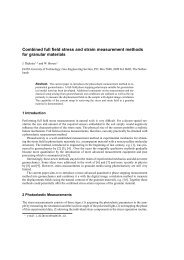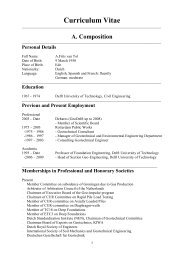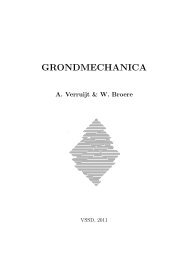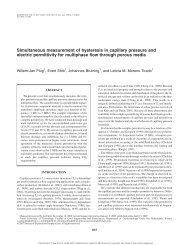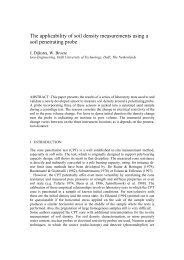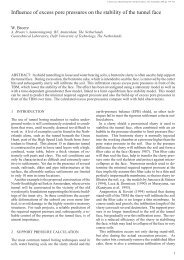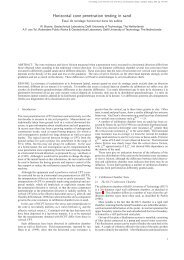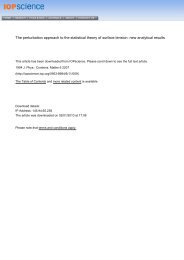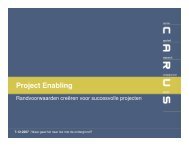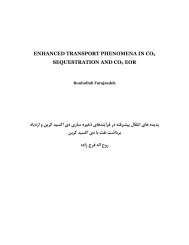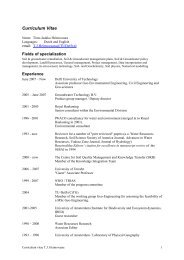Tunnel Face Stability & New CPT Applications - Geo-Engineering
Tunnel Face Stability & New CPT Applications - Geo-Engineering
Tunnel Face Stability & New CPT Applications - Geo-Engineering
You also want an ePaper? Increase the reach of your titles
YUMPU automatically turns print PDFs into web optimized ePapers that Google loves.
20 2. <strong>Stability</strong> Analysis of the <strong>Tunnel</strong> <strong>Face</strong>resulting in an unsafe estimate of the maximal support pressure. For highly overconsolidatedsoils with K 0 ≥ 1, the horizontal effective stress may be greater than the vertical, as a result ofwhich horizontal fracturing will occur at a stress significantly lower than determined by (2.21).Bezuijen [35] states a more general formula,s f = σ 3 + η f c u (2.22)which defaults to (2.21) for η f = 2 and normally consolidated soil. Bezuijen holds that whentaking η f = 1, this expression will yield safe estimates of the maximum allowable supportpressure.Comparing the maximal allowable support pressures resulting from the various models, thefrictionless blow-out model in general yields the lowest maximal allowable pressure, followedby the requirements resulting from fracturing, blow-out mechanisms including shear forces andfinally global stability analyses for the maximal allowable support pressure.Another mechanism which has been named as a possible method to create a flow channelfrom the face to the surface is piping. However, piping is caused by a sufficiently large exitgradient of the support medium at the surface and this gradient is small in a regular boringprocess. In case a slurry shield is used with no filter cake present at the face, the exit gradientscould be expected to be of the magnitude needed to wash out particles at the surface. Then aflow channel could be created by continued erosion, a process which generally takes place ona larger timescale than the boring process. As such it is not deemed a very likely mechanism.Furthermore the support pressures needed to create a large enough pressure gradient are so largethat other mechanisms are likely to occur sooner, which further decreases the likelihood of pipingoccuring as a failure mechanism of the tunnel face.2.1.4 Laboratory and Field ObservationsThe validity of the stability models should preferably be backed by field observations. Thelarge number of unknowns often present in field conditions and the high costs resulting from acollapse of the face and subsequent stand-still of the tunnel boring process are major reasons thatmost researchers have used laboratory tests to investigate the boundaries of allowable supportpressures and to support their models. These tests can be broken down into geocentrifugetests, 1g laboratory tests like extrusion tests and scale model analogs. Examples from all thesecategories will be given and their applicability to the problem of face stability briefly mentioned.Furthermore, even where projects are well documented and extensive information on the soilconditions is given in literature, measurements of the actually used support pressures are hardlyever given, and cases where a direct connection is made between support pressure measurementsand face instabilities are almost non-existent. A few cases where sufficient information isavailable will be discussed in section 2.4 and used to validate the stability model developed insection 2.2. Lacking data on actual collapses, one can alternatively use the design guidelinesand measured pressures of the regular boring process to establish a range of suitable workingpressures. The bounds of this range may give an indication of the minimal and maximal allowablesupport pressures, especially if the difference between the bounds is reasonably small. To thisend we will also look at estimative methods and rough guidelines for the support pressure.Several authors have reported investigations on the face stability of tunnels using geocentrifuges.These tests can be divided into tests on supported and (partially) unsupportedtunnels, or into tests on sandy or clayey soils. Tests in sandy soils are almost without exceptionmade with a supported model tunnel. In these tests the method of face support can differ. In the



